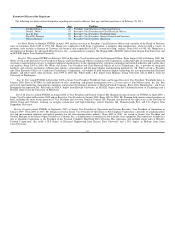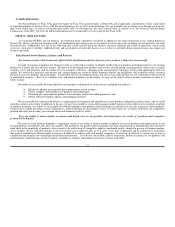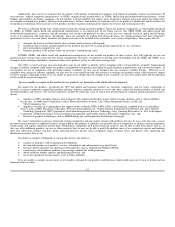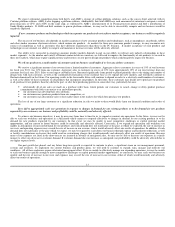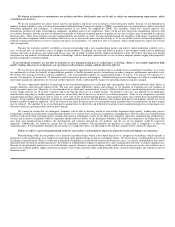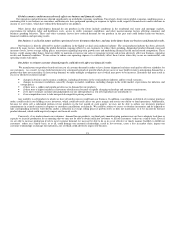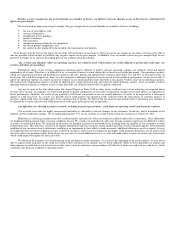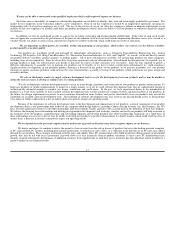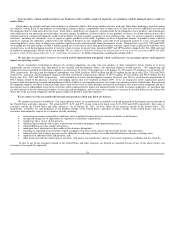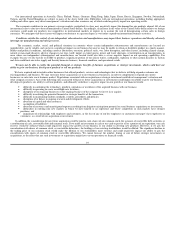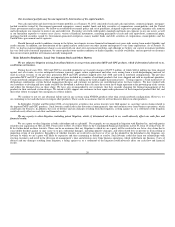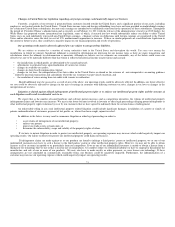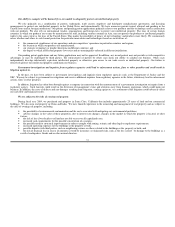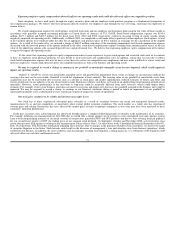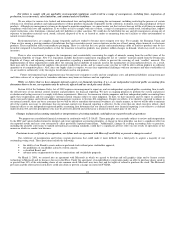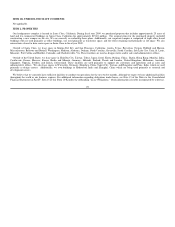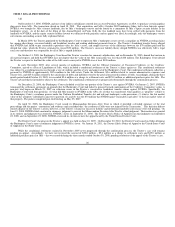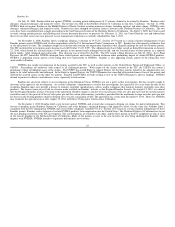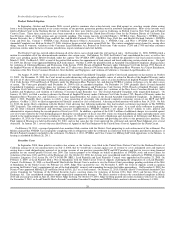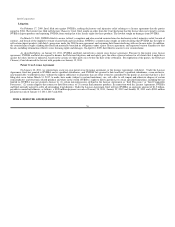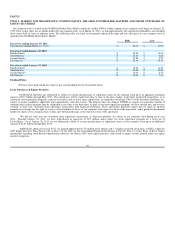NVIDIA 2011 Annual Report Download - page 22
Download and view the complete annual report
Please find page 22 of the 2011 NVIDIA annual report below. You can navigate through the pages in the report by either clicking on the pages listed below, or by using the keyword search tool below to find specific information within the annual report.
Our investment portfolio may become impaired by deterioration of the capital markets.
Our cash equivalent and short-term investment portfolio as of January 30, 2011 consisted of cash and cash equivalents, commercial paper, mortgage-
backed securities issued by Government-sponsored enterprises, money market funds and debt securities of corporations, municipalities and the United
States government and its agencies. We follow an established investment policy and set of guidelines, designed to preserve principal, minimize risk, monitor
and help mitigate our exposure to interest rate and credit risk. The policy sets forth credit quality standards and limits our exposure to any one issuer, as well
as our maximum exposure to various asset classes, variety of financial instruments, consisting principally of cash and cash equivalents, commercial paper,
mortgage-backed securities issued by Government-sponsored enterprises, money market funds and debt securities of corporations, municipalities and the
United States government and its agencies.
Should financial market conditions worsen in the future, investments in some financial instruments may pose risks arising from market liquidity and
credit concerns. In addition, any deterioration of the capital markets could cause our other income and expense to vary from expectations. As of January 30,
2011, we had no material impairment charges associated with our short-term investment portfolio, and although we believe our current investment portfolio
has very little risk of material impairment, we cannot predict future market conditions or market liquidity, or credit availability, and can provide no assurance
that our investment portfolio will remain materially unimpaired.
Risks Related to Regulatory, Legal, Our Common Stock and Other Matters
We are subject to litigation arising from alleged defects in our previous generation MCP and GPU products, which if determined adversely to us,
could harm our business.
During fiscal years 2011, 2010 and 2009 we recorded cumulative net warranty charges of $475.9 million, of which $466.4 million has been charged
against cost of revenue, to cover anticipated customer warranty, repair, return, replacement and other costs arising from a weak die/packaging material set
used in certain versions of our previous generation MCP and GPU products shipped after July 2008 and used in notebook configurations. The previous
generation MCP and GPU products that are impacted were included in a number of notebook products that were shipped and sold in significant quantities.
Certain notebook configurations of these MCP and GPU products are failing in the field at higher than normal rates. Testing suggests a weak material set of
die/package combination, system thermal management designs, and customer use patterns are contributing factors for these failures. We have worked with
our customers to develop and have made available for download a software driver to cause the system fan to begin operation at the powering up of the system
and reduce the thermal stress on these chips. We have also recommended to our customers that they consider changing the thermal management of the
products in their notebook system designs. We intend to fully support our customers in their repair and replacement of these impacted products that fail, and
their other efforts to mitigate the consequences of these failures.
We continue to not see any abnormal failure rates in any systems using NVIDIA products other than certain notebook configurations. However, we
are continuing to test and otherwise investigate other products. There can be no assurance that we will not discover defects in other products.
In September, October and November 2008, several putative securities class action lawsuits were filed against us, asserting various claims related to
the impacted MCP and GPU products. Such lawsuits could result in the diversion of management’s time and attention away from business operations, which
could harm our business. In addition, the costs of defense and any damages resulting from this litigation, a ruling against us, or a settlement of the litigation
could adversely affect our cash flow and financial results.
We are a party to other litigation, including patent litigation, which, if determined adversely to us, could adversely affect our cash flow and
financial results.
We are a party to other litigation as both a defendant and as a plaintiff. For example, we are engaged in litigation with Rambus Inc. and with parties
related to our acquisition of 3dfx in 2001. Please refer to Note 13 of these Notes to the Consolidated Financial Statements in Part IV, Item 15 of this Form 10-
K for further detail on these lawsuits. There can be no assurance that any litigation to which we are a party will be resolved in our favor. Any claim that is
successfully decided against us may cause us to pay substantial damages, including punitive damages, and other related fees or prevent us from selling or
importing certain of our products. Regardless of whether lawsuits are resolved in our favor or if we are the plaintiff or the defendant in the litigation, any
lawsuits to which we are a party will likely be expensive and time consuming to defend or resolve. Such lawsuits could also harm our relationships with
existing customers and result in the diversion of management’s time and attention away from business operations, which could harm our business. Costs of
defense and any damages resulting from litigation, a ruling against us, or a settlement of the litigation could adversely affect our cash flow and financial
results.
20


